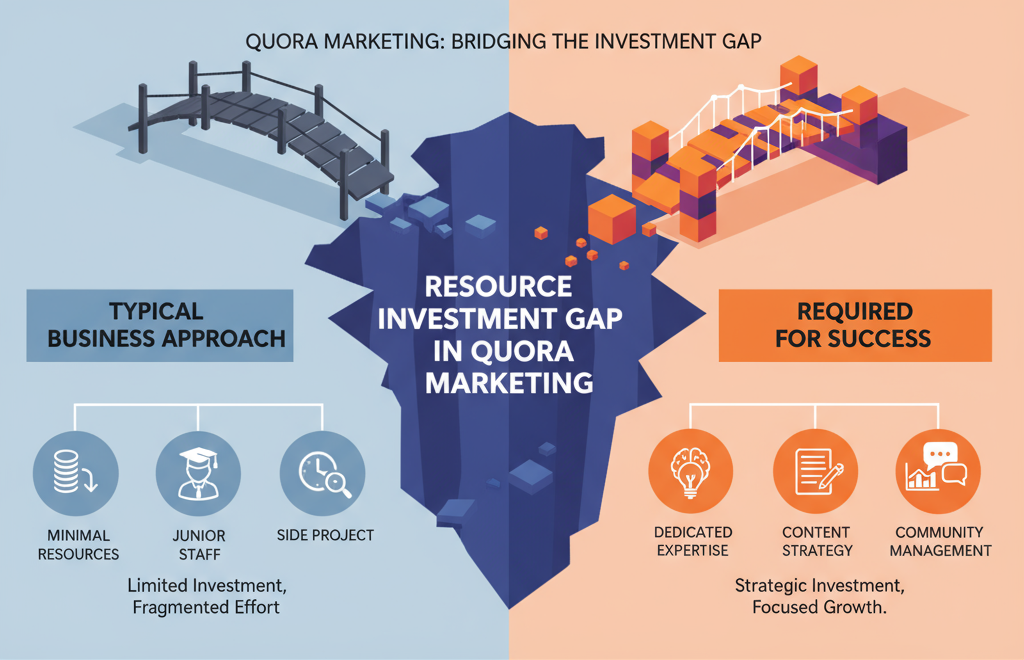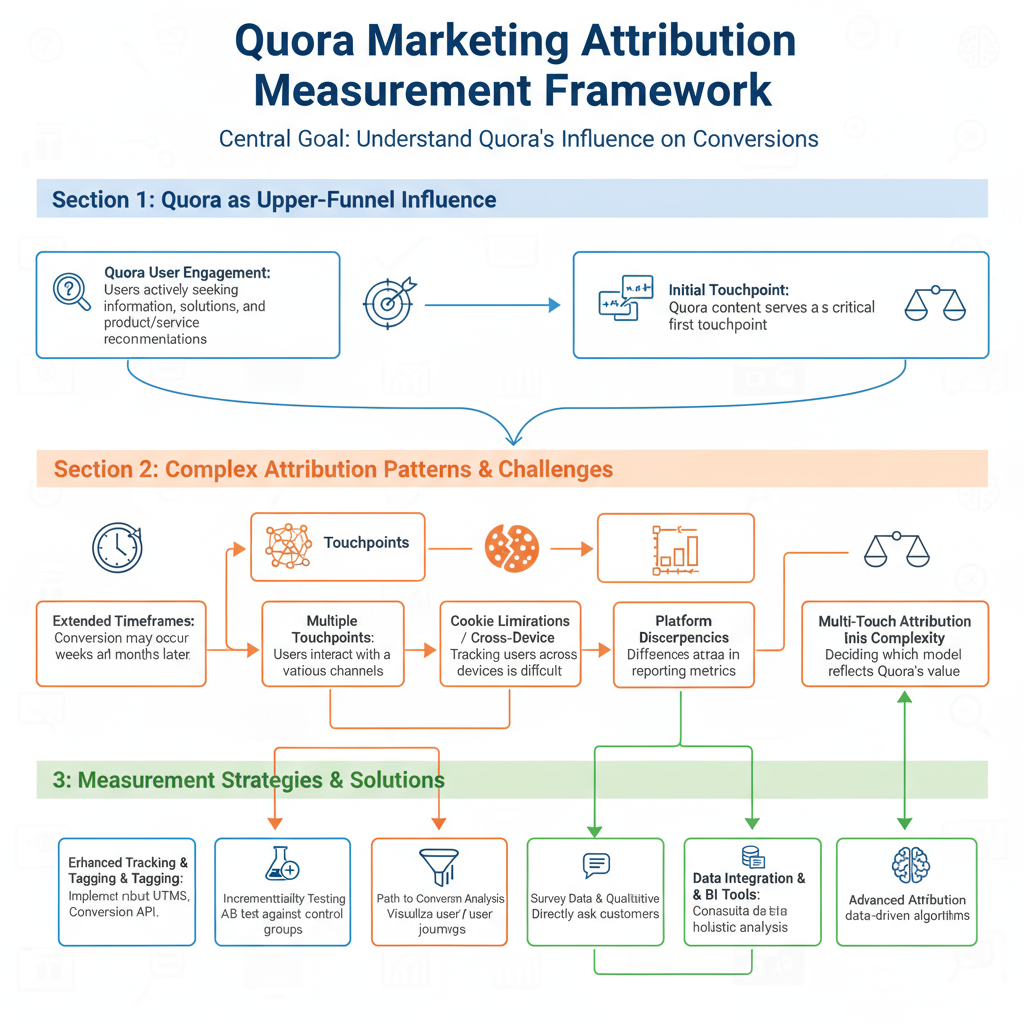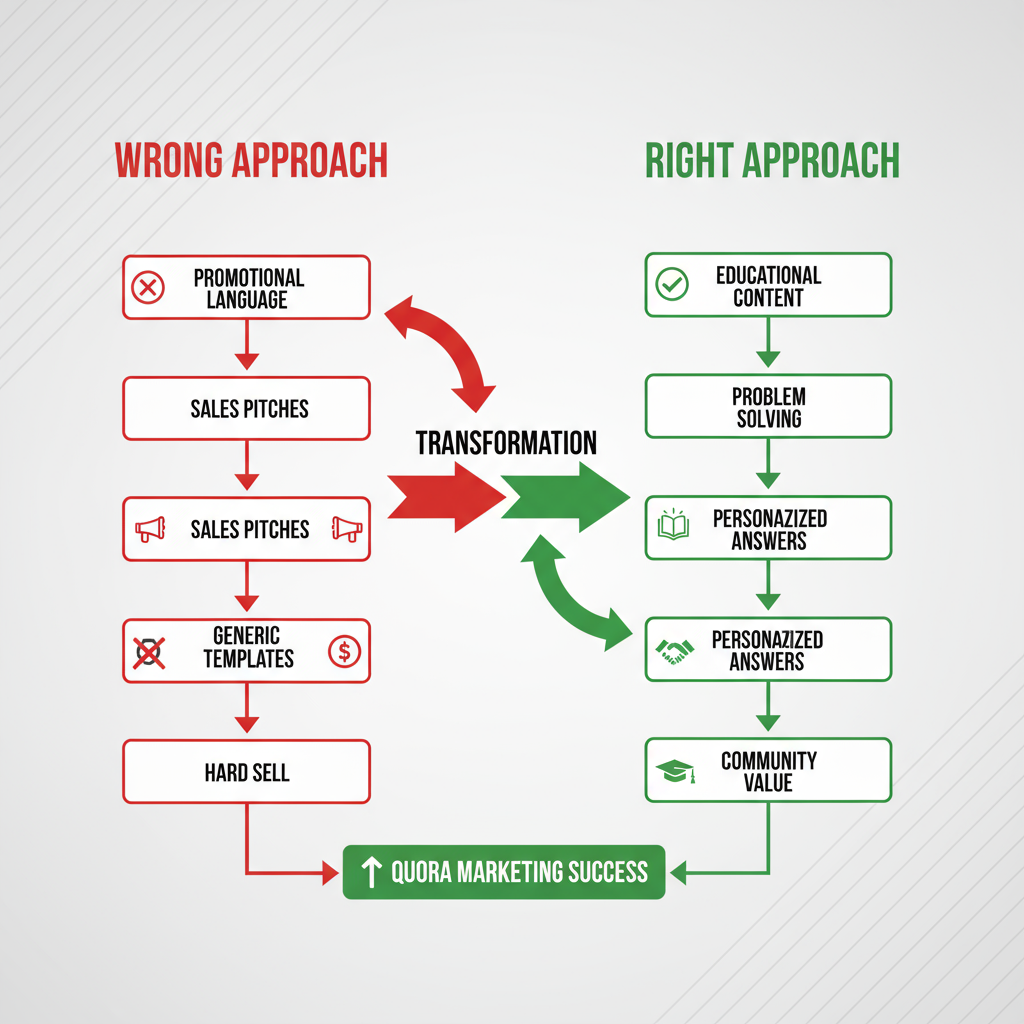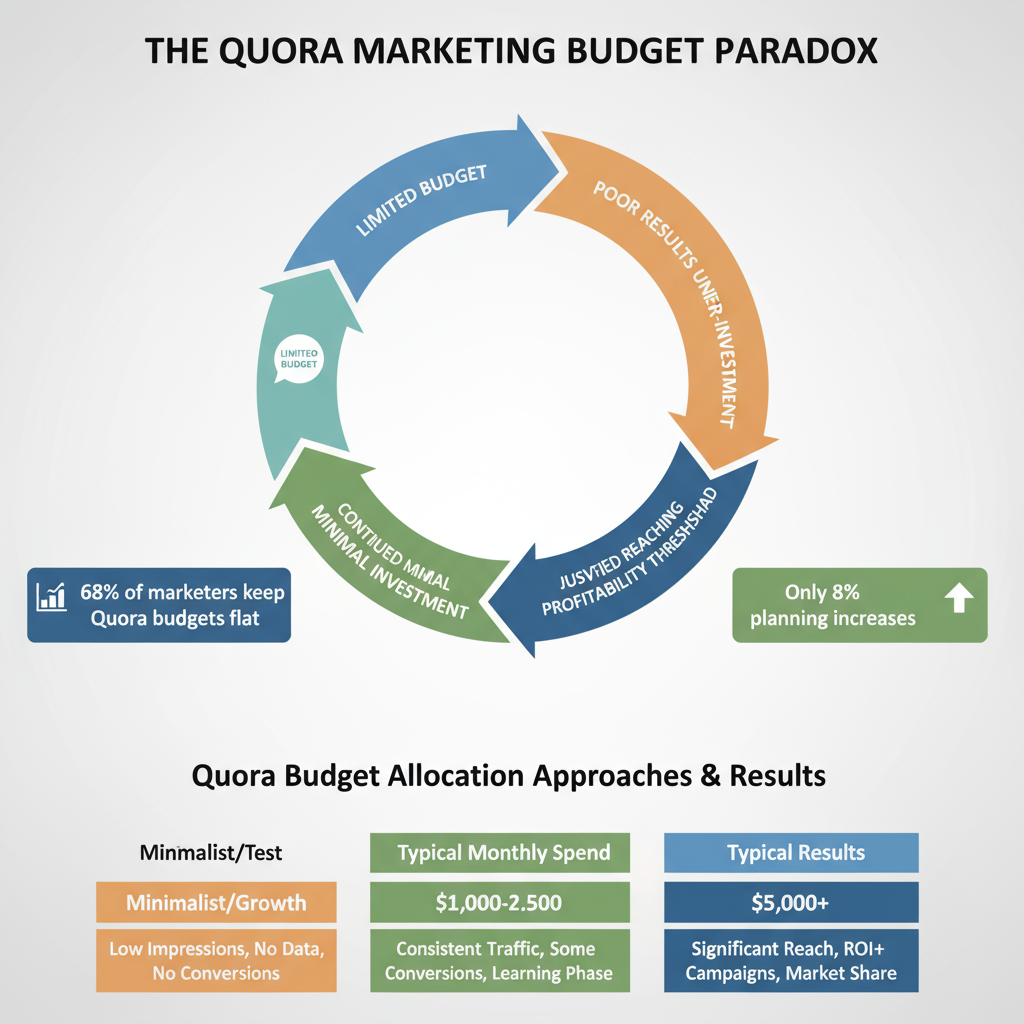8 Critical Quora Marketing Factors Most Businesses Miss
The stark reality of Quora marketing in 2025 reveals a troubling pattern: while some businesses achieve conversion rates up to 4× higher than other digital platforms, 68% of marketers worldwide planned to keep their Quora spending flat, and nearly one in four planned budget cuts. This dramatic performance gap isn’t random. It reflects critical success factors that most businesses systematically overlook or underestimate.
The difference between Quora marketing success and failure often comes down to understanding the platform’s unique ecosystem and aligning strategy accordingly. Yet most organizations treat it like any other advertising channel rather than recognizing its sophisticated requirements for content marketing, community management, and specialized technical implementation. Ready to transform your Quora approach? Get Your Customized Quora Strategy to explore your options.
Critical Factor #1: The Resource Investment Gap

The most pervasive factor businesses miss is the fundamental resource investment gap that prevents successful Quora marketing implementation. The platform demands sophisticated capabilities that blend content marketing, SEO, community management, and data analysis, yet many companies assign Quora marketing to junior marketers as a side project or attempt to manage it without dedicated expertise.
This under-investment creates a vicious cycle where insufficient resources lead to poor results, which then justify continued minimal investment, preventing companies from reaching the threshold where Quora marketing becomes profitable and scalable. The resource requirements extend far beyond what most businesses anticipate, requiring multiple specialized roles working in coordination rather than a single generalist attempting to manage all aspects.
“Successful Quora marketing requires dedicated expertise across content strategy, subject matter knowledge, community management, and analytics capabilities. Attempting to assign these responsibilities to generalist marketing personnel typically results in suboptimal performance across all dimensions.” – Industry Analysis Report
The foundational requirement centers on deep audience research capabilities, where teams must develop crystal-clear understanding of target audiences’ needs, pain points, and motivations rather than relying on surface-level demographics. This audience research goes beyond traditional marketing personas to understand how prospects behave specifically on Quora, what questions they ask, what topics they follow, and which influential voices guide their communities.
Content creation represents another critical resource gap that businesses consistently underestimate. Successful Quora marketing requires content creators who function as storytellers, educators, and problem-solvers rather than traditional promotional copywriters. These individuals need deep subject matter expertise in the company’s industry, products, and customer pain points, combined with mastery of Quora’s platform-specific nuances including optimal answer length, formatting requirements, image usage, and link placement strategies.
Critical Factor #2: The Mobile-First Reality Crisis
The mobile optimization imperative represents one of the most critical factors that businesses systematically miss, despite overwhelming evidence that mobile dominance defines Quora’s user behavior patterns. More than 80% of Quora Ads impressions and click-throughs originate from mobile devices, yet most businesses optimize their conversion funnels for desktop experiences, creating fundamental mismatches that undermine campaign performance.
This mobile-desktop disconnect becomes particularly problematic for B2B companies and SaaS providers who historically focused optimization efforts on desktop users under the assumption that business decision-makers research software during traditional work hours on company computers. The mobile optimization challenge extends far beyond simple responsive design implementation.
| Mobile Optimization Factor | Impact on Performance | Common Business Gap |
|---|---|---|
| Mobile-First Design | Significantly higher conversion rates | Desktop-centric funnel design |
| Page Load Speed | Critical for user retention | Unoptimized mobile experience |
| Form Simplification | Improved completion rates | Complex desktop-style forms |
| Touch-Friendly Interface | Better engagement metrics | Click-based interaction design |
E-commerce brands and SaaS companies must redesign entire conversion funnels to accommodate mobile users who research solutions during non-traditional contexts like commutes, breaks, or personal time rather than dedicated work sessions. This contextual shift requires simplified forms, streamlined onboarding processes, and mobile-optimized content experiences that most companies have not prioritized in their conversion optimization strategies.
Mobile users on Quora exhibit distinctly different engagement patterns compared to desktop users, creating additional complexity for conversion optimization. Mobile users typically seek quick answers or browse casually, which means content must be optimized for mobile consumption while maintaining the depth needed for complex purchase decisions. This creates inherent tension between comprehensive product information and mobile-friendly content formats that businesses struggle to resolve effectively.
Critical Factor #3: Attribution Measurement Blindness

The attribution measurement challenge represents perhaps the most sophisticated factor that businesses miss, creating systematic blind spots that prevent accurate ROI assessment and optimization decision-making. Quora’s unique position as a knowledge-sharing platform creates distinctive attribution patterns that differ significantly from traditional social media advertising, as users typically arrive with research intent and consume educational content that influences purchase decisions over extended timeframes.
This research-oriented behavior means Quora often plays an upper-funnel role that influences conversions attributed to other channels using last-click attribution models, creating measurement gaps that undervalue the platform’s true contribution. The platform’s dependency on third-party cookies for conversion matching creates systematic attribution gaps that most businesses fail to recognize or address.
With Quora recording a 64.92% bounce rate and average visit duration of 2 minutes 39 seconds, many users leave before pixels fire or cookies are properly set, leading to under-reported conversions in attribution data. The evolving privacy landscape compounds these challenges as Safari and Firefox eliminate third-party cookie support while Chrome’s ongoing privacy initiatives continue limiting traditional tracking mechanisms.
“Advanced practitioners address attribution measurement blindness through sophisticated tracking implementations that capture Quora’s unique influence patterns. Server-side tracking and dynamic UTM parameters help capture more complete conversion data, as browser-based tracking often misses mobile conversions due to ad blockers and privacy settings.” – Marketing Analytics Research
Platform discrepancy issues create additional measurement complexity that misleads optimization efforts. Quora counts individual clicks regardless of whether the same user clicks multiple times, while Google Analytics measures unique users and sessions, typically resulting in Quora reporting higher click volumes than corresponding analytics data and creating apparent discrepancies in cost-per-click and conversion rate calculations.
Multi-touch attribution complexity represents another critical measurement factor that businesses systematically overlook. Each advertising platform operates within its own measurement ecosystem, creating data silos that prevent comprehensive understanding of how different touchpoints contribute to customer acquisition outcomes. Platform-specific attribution models create conflicting claims on conversion credit when customers interact with multiple advertising channels during their journey, often resulting in total attributed conversions exceeding actual conversion volumes when data is aggregated across platforms.
Critical Factor #4: Content Strategy Misalignment

The content strategy misalignment factor represents one of the most damaging mistakes that businesses make on Quora, stemming from fundamental misunderstanding of the platform’s community dynamics and user expectations. The most common and destructive approach involves treating Quora as a virtual billboard, plastering answers with promotional language, sales pitches, and aggressive calls to action while forgetting that Quora functions as a community of learners rather than a marketplace of buyers.
This hard sell approach violates the platform’s core ethos and alienates target audiences who can easily identify sales pitches and respond with downvotes, spam flags, or account blocks that devastate brand reputation. The copy-paste catastrophe emerges as another widespread content strategy failure where marketers rush to answer multiple questions using generic, uninspired template responses.
This approach demonstrates fundamental misunderstanding of Quora user expectations, as the community seeks personalized, in-depth answers that directly address specific questions rather than one-size-fits-all responses that appear robotic. Generic answers signal to the community that businesses aren’t willing to invest effort in providing thoughtful responses, making brands appear lazy, uninspired, and untrustworthy.
The content-intent misalignment problem becomes particularly acute for SaaS companies, which naturally incline toward promoting product features while Quora’s audience expects solution-oriented content. Research shows that 67.8% of Quora users research product information online before making purchase decisions, indicating they’re in active research mode seeking detailed, comparative information rather than promotional material.
This research-heavy audience can quickly identify and dismiss superficial or overly promotional content, requiring SaaS companies to develop sophisticated content strategies that demonstrate genuine expertise while addressing real customer pain points comprehensively. Successful content strategy alignment requires shifting from feature promotion to problem-solving education, where companies focus on helping users understand solutions to their challenges rather than highlighting specific product capabilities.
For businesses struggling with these complex content strategy challenges, professional guidance becomes essential. Get Your Customized Quora Strategy to discuss your specific content alignment needs.
Critical Factor #5: The Budget Allocation Paradox

The budget allocation paradox represents a critical factor that undermines Quora marketing success through systematic under-investment that prevents the testing and optimization cycles required for platform mastery. Industry data reveals that 68% of global PPC marketers expected to keep their Quora Ads budgets flat for 2025, with only 8% planning increases, creating a vicious cycle where limited financial commitment prevents meaningful results that could justify increased investment.
This budgetary hesitancy reflects fundamental misunderstanding of Quora’s unique requirements for sustained investment before generating measurable returns, unlike paid search campaigns that can produce immediate traffic. The flat budget allocation creates performance optimization barriers that prevent companies from reaching profitability thresholds.
Without sufficient investment in content creation and campaign optimization, businesses fail to see meaningful results, which then justify continued under-investment and prevent reaching the point where Quora marketing becomes profitable and scalable. This creates a self-fulfilling prophecy where businesses conclude Quora doesn’t work for them due to insufficient investment in proper implementation and optimization.
| Budget Allocation Approach | Typical Results | Success Rate |
|---|---|---|
| Significant Budget Increases | Strong performance gains | Higher success rates |
| Modest Budget Increases | Moderate improvements | Mixed results |
| Flat Budgets | Limited growth | Poor outcomes |
| Budget Decreases | Performance decline | Failed campaigns |
Quora’s minimum daily budget requirement of five dollars per campaign creates structural challenges that amplify quickly as targeting strategies expand. Comprehensive targeting across ten different topic areas with individual campaigns requires minimum daily spend of fifty dollars just to meet platform requirements, before considering competitive bidding pressures that can drive costs significantly higher.
The platform’s auction-based system creates additional budget allocation complexity where performance metrics vary significantly based on competitive pressure within specific topics. Cost-per-click rates typically range significantly higher than Google Display Network campaigns, with suggested bid ranges often exceeding six dollars for competitive topics.
While the platform justifies this premium through higher user intent and engagement levels, elevated costs compound quickly when scaling campaigns across multiple topics, audiences, and geographic regions. Campaign-level budget allocation while bidding occurs at the ad set level creates structural tension that becomes amplified as operations scale.
Critical Factor #6: Audience Understanding Deficits
The audience understanding deficit represents a fundamental factor that undermines Quora marketing effectiveness through systematic misalignment between targeting strategies and platform user behavior patterns. Quora’s audience targeting capabilities present significant constraints that become apparent when marketers attempt to expand beyond initial pilot campaigns into comprehensive marketing programs, as the platform relies heavily on topic-based categorization rather than sophisticated demographic and behavioral targeting options available on more mature advertising platforms.
The demographic composition of Quora users creates unique targeting opportunities that most businesses fail to leverage effectively. Platform statistics reveal that 61.35% of users are male, with 31.12% aged 25 to 34 and 29.63% aged 18 to 24, representing a professional demographic with significant decision-making authority.
Critically, 37% of adult Quora users are more likely to be in management positions, while 28% of adults on the platform earn $100,000 annually or higher, making them twice as likely to engage on Quora compared to LinkedIn users. This high-value demographic represents unprecedented targeting opportunities for B2B businesses and premium service providers.
Educational qualifications add another layer of audience sophistication that businesses often overlook in their targeting and content strategies. 65% of Quora users hold college degrees while 28% have graduate degrees, creating an educated professional audience that expects comprehensive, authoritative content rather than superficial promotional material.
“This high education level means users can quickly identify and dismiss content that lacks substance or appears overly promotional, requiring more sophisticated content approaches than typical social media marketing.” – Audience Research Analysis
Geographic distribution patterns reveal additional targeting complexity that affects international marketing strategies. The United States represents 37.94% of Quora users, followed by India at 15.39%, the United Kingdom at 5.99%, Canada at 4.45%, and Australia at 3.09%. This distribution creates opportunities and challenges for businesses targeting different markets, particularly when considering that emerging markets offer lower cost-per-click rates but may have limited audience sizes for specific topic areas.
Mobile usage patterns fundamentally shape audience behavior in ways that many businesses fail to account for in their strategy development. With 75% of Quora traffic originating from mobile devices, user engagement patterns differ significantly from desktop-based research behavior. Mobile users often consume content during non-traditional research contexts, requiring content and conversion strategies optimized for casual browsing rather than dedicated research sessions.
Critical Factor #7: The Community Engagement Gap
Another critical factor that businesses consistently miss is the community engagement gap. Many businesses approach Quora with a broadcast mentality, pushing out content without actively participating in the community. This one-way communication style fails to build the trust and credibility that are essential for success on the platform.
Effective community engagement involves more than just answering questions. It means upvoting valuable content from other users, following relevant topics and influencers, and participating in conversations in a genuine and helpful way. It’s about becoming a valued member of the community, not just a marketer trying to sell a product.
Critical Factor #8: The Technical Implementation Gap
Finally, the technical implementation gap is a major hurdle for many businesses. This includes everything from properly setting up conversion tracking to implementing advanced features like server-side tracking and dynamic UTM parameters. Without a solid technical foundation, it’s impossible to accurately measure performance, optimize campaigns, and achieve a positive ROI.
This is another area where a lack of specialized expertise can be a major roadblock. The technical requirements for successful Quora marketing are often beyond the capabilities of a generalist marketing team, requiring a deep understanding of analytics, tracking, and platform-specific APIs.
How to Systematically Address These Critical Factors
Addressing these critical Quora marketing factors requires a systematic methodology rather than ad hoc tactical approaches. Successful businesses develop comprehensive frameworks that integrate platform understanding, resource allocation, technical implementation, and performance optimization into cohesive strategies that deliver sustainable results.
The foundation begins with realistic resource planning that acknowledges Quora marketing’s specialized requirements. This means investing in appropriate expertise, whether through internal team development or professional services partnerships that provide immediate access to proven capabilities and optimization frameworks.
Content strategy development must prioritize educational value creation over promotional messaging, recognizing that Quora’s community rewards authentic expertise and genuine helpfulness. This requires deep customer research, industry knowledge, and platform-specific content optimization that most businesses struggle to develop internally.
Technical implementation encompasses sophisticated measurement systems, campaign structure optimization, and integration with broader marketing technology stacks. These technical requirements often exceed typical marketing team capabilities, requiring specialized knowledge and infrastructure investment.
Attribution modeling complexity demands understanding of multi-touch customer journeys and extended B2B sales cycles. Businesses must implement measurement frameworks that capture Quora’s upper-funnel influence rather than relying on traditional attribution models that systematically undervalue the platform’s contribution.
Performance optimization requires continuous testing and refinement based on platform-specific metrics and community feedback. This ongoing optimization process demands analytical capabilities and platform expertise that enable strategic decision-making and sustainable growth.
For businesses serious about Quora marketing success, addressing these critical factors systematically becomes essential. The learning curve is steep, the resource requirements are substantial, and the technical complexity is significant. However, the businesses that invest appropriately and avoid these common pitfalls position themselves to capitalize on one of the most underutilized yet powerful marketing channels available.
The choice of approach will significantly impact your Quora marketing outcomes and long-term competitive positioning. Whether developing internal capabilities or partnering with specialized expertise, success depends on recognizing and systematically addressing these critical factors that most businesses continue to miss entirely. Get Your Customized Quora Strategy to discuss your specific challenges and growth objectives with experts who understand these critical success elements.
How Single Grain Addresses These Critical Factors
While most businesses struggle with these critical Quora marketing factors, Single Grain has developed proven methodologies that systematically address each challenge through specialized expertise and comprehensive service delivery. Our approach combines deep platform understanding with data-driven optimization frameworks that eliminate the guesswork from Quora marketing success.
Our resource allocation strategy begins with dedicated team assignments where experienced Quora specialists focus exclusively on platform optimization rather than managing it as a secondary responsibility. We maintain specialized roles for content strategy, community management, technical implementation, and performance analysis, ensuring each critical success factor receives appropriate expert attention.
Our mobile-first optimization approach addresses the conversion crisis through a comprehensive funnel redesign that prioritizes mobile user experiences from initial content engagement through final conversion. We implement server-side tracking and dynamic attribution systems that capture more complete conversion data across all devices, eliminating many of the measurement gaps that plague most Quora marketing efforts.
“Single Grain’s approach to Quora marketing combines technical sophistication with community-focused content strategy, addressing the platform’s unique requirements through specialized expertise and proven optimization frameworks.” – Client Success Analysis
For content strategy alignment, we develop platform-specific educational content that demonstrates genuine expertise while subtly positioning client solutions within broader problem-solving contexts. Our content creators understand Quora’s community dynamics and create comprehensive, authoritative answers that build trust and credibility rather than appearing promotional or superficial.
Our attribution measurement systems implement advanced multi-touch modeling that captures Quora’s upper-funnel influence on extended B2B sales cycles. We use sophisticated tracking implementations including server-side measurement and dynamic UTM parameters that provide more accurate performance data despite privacy restrictions and mobile browsing challenges.
Budget allocation optimization leverages our platform expertise to identify optimal investment thresholds and scaling opportunities. We develop comprehensive campaign structures that maximize coverage while managing complexity, ensuring clients reach the performance levels where Quora marketing becomes profitable and scalable.
Our audience targeting strategies capitalize on Quora’s unique demographic characteristics and intent-based engagement patterns. We develop sophisticated targeting approaches that align with platform user behavior and expectations, maximizing engagement from high-value professional audiences who are actively researching business solutions.
Discover how Single Grain can accelerate your growth. Get Your Customized Quora Strategy to discuss your specific needs and see how we address these critical factors for your business.
Frequently Asked Questions (FAQs)
-
1. What is the single biggest mistake businesses make on Quora?
The biggest mistake is treating it like a traditional advertising platform. Quora is a community built on knowledge sharing and trust. A hard-sell, promotional approach will backfire. The key is to provide genuine value and build credibility through high-quality, educational content.
-
2. How long does it take to see results from Quora marketing?
Unlike paid search, which can generate immediate traffic, Quora marketing is a long-term play. It takes time to build authority, understand the nuances of the platform, and optimize your campaigns. Expect to invest several months of consistent effort before you start to see significant, scalable results. Get Your Customized Quora Strategy
-
3. Is Quora only for B2C companies?
Absolutely not. Quora is a powerful channel for B2B marketers as well. With a highly educated and professional user base, it’s an ideal platform for reaching decision-makers who are actively researching solutions to their business problems. Get Your Customized Quora Strategy



